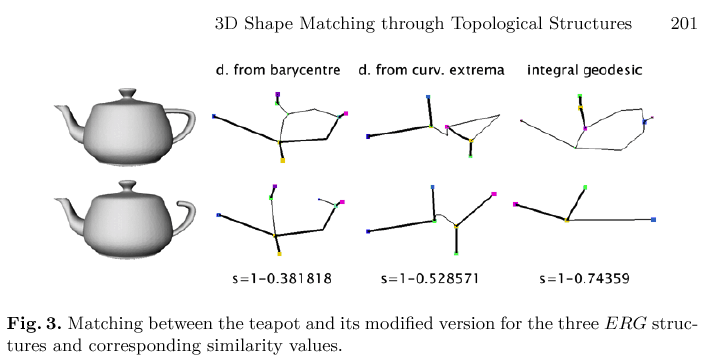
Feb. 17, 2004
Publications in Graphics on Shape by Silvia Biasotti et al.:
BibTeX references.
Shape Modelling Group (SMG)
Institute of Applied Mathematics and Information Technology
Genova (IMATI-Ge), Italian National Council of Research (CNR)
Biasotti S., Marini S., Mortara M., Patanè G.
IEEE Proceedings of International Conference on
Shape Modelling International and Applications (SMI), pp.
245-256.
Seoul National University, Seoul, Korea, 12-16 May 2003.
This paper investigates the main issues related to the definition of abstraction tools for deriving high-level descriptions of complex geometric models. Among the wide range of shape descriptors, topological graph-like representations not only give a powerful and synthetic sketch of the object, but also capture its inner structure, that is how features connect together to give the overall shape. This aspect makes them useful to describe complex 3D objects in various applications like modelling, morphing, matching and recognition. The paper surveys the main properties of skeletons developed in Shape Modelling for representing objects.
Biasotti S., Marini S., Mortara M., Patanè G., Spagnuolo M., Falcidieno B.
Lecture notes in computer science, vol. 2886, pp.:194-203, 2003.
LNCS 2886 - Discrete Geometry for Computer Imagery (DGCI'03)
This paper introduces a framework for the matching of 3D shapes represented by topological graphs. The method proposes as comparison algorithm an error tolerant graph isomorphism that includes a structured process for identifying matched areas on the input objects. Finally, we provide a series of experiments showing its capability to automatically compare complex objects starting from different skeletal representations used in Shape Modeling.


Silvia Biasotti
Central European Seminar on Computer Graphics,
CESCG 2001, Bratislava, Slovakia 2001
This paper presents our recent results in the field of surface representation based on topological coding. In particular, we investigate a possible way to adapt to discrete surface models some theoretical concepts as Morse theory and Reeb graphs which bases on differential topology. Starting from a triangulated surface, our aim is to code the relationship among critical points of the height function associated to the mesh. We named Extended Reeb Graph (ERG) the graph representation which can handle also degenerate critical points. The ERG gives an effective representation of the surface shape available for classification, simplification and restoring purposes.
Page created & maintained by Frederic Leymarie, 2004.
Comments, suggestions, etc., mail to: leymarie@lems.brown.edu